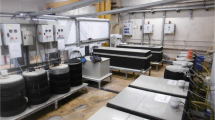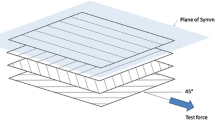Abstract
The development of ocean energy conversion systems places more severe requirements on materials than similar land-based structures such as wind turbines. Intervention and maintenance at sea are very costly, so for ocean energy supply to become economically viable long term durability must be guaranteed. Cyclic loading is a common feature of most energy conversion devices and composites are widely used, but few data are available concerning the fatigue behaviour in sea water of composite materials. This paper presents the results from an experimental study to fill this gap. The fatigue behavior of composite materials reinforced with different types of glass fibre is characterized in air and in sea water; the influence of testing in sea water rather than air is shown to be small. However, sea water ageing is shown to reduce the fatigue lifetime significantly and strongly depends on matrix formulation.










Similar content being viewed by others
References
European Commission, Ocean Energy Conversion in Europe. Centre for renewable energy sources, (2006), http://www.wavec.org/client/files/OceanEnergyConversionEurope_CRES.pdf
Bahaj, A.S.: Generating electricity from the oceans. Ren. And Sust. Energy Reviews 15, 3399–3416 (2011)
Boisseau, A., Davies, P., Thiébaud, F.: Sea water ageing of composites for ocean energy conversion systems: influence of glass fibre type on static behaviour. Published on-line in Applied Composite Materials, (2011), doi:10.1007/s10443-011-9219-6
Harris, B., ed. Fatigue in Composites: Woodhead Publishers, Cambridge, England (2003)
Echtermeyer, A.T., Kensche, C., Bach, P., Poppen, M., Lilholt, H., Andersen, S.I., et al.: Method to predict fatigue lifetimes of GRP wind turbine blades and comparison with experiments. The European Union wind energy conference and exhibition; 20–24 May, 1996; Göteborg. Stephens and Associates, Sweden (1996)
Nijssen, R.P.L., Van Wingerde, A.M., Van Delft, D.R.V.: Wind turbine rotor blade materials: estimating service lives. SAMPE Journal 43(No 2), 7–15 (2007)
OPTIMAT European project, database on-line, website: http://www.wmc.eu/optimatblades_optidat.php
Sutherland, H.J., Mandell, J.F.: Application of the U.S. high cycle fatigue data base to wind turbine blade lifetime predictions. Energy Week 1996, ASME; (1996)
Guedes, R.M.: Creep and fatigue lifetime prediction of polymer matrix composites based on simple cumulative damage laws. Composites Part A: Applied Science and Manufacturing 39(11), 1716–1725 (2008)
Ronold, K.O., Christensen, C.J.: Optimization of a design code for wind-turbine rotor blades in fatigue. Eng. Struct. 23(8), 993–1004 (2001)
Tarp-Johansen, N.J.: Examples of Fatigue Lifetime and Reliability Evaluation of Larger Wind Turbine Components, Riso Report R-1418 (EN) March (2003)
Price, J.N., Hull, D.: Effect of matrix toughness on crack propagation during stress corrosion of glass reinforced composites. Comp. Sci. & Tech. 28, 193–210 (1987)
Renaud, C.M., Greenwood, M.E.: Effect of glass fibres and environments on long-term durability of GFRP Composites. (2002)
Neuman, S., Marom, G.: Stress dependence of the coefficient of moisture diffusion in composite materials. Polymer Composite, 6(1), 9–12
Suri, C., Perreux, D.: The effects of mechanical damage in a glass fibre/epoxy composite on the absorption rate. Compos. Eng. 5(4), 415–424 (1995)
Kotsikos, G., Evans, J.T., Gibson, A.G., Hale, J.M.: Environmentally enhanced fatigue damage in glass fibre reinforced composites characterised by acoustic emission. Composites Part A 31, 969–977 (2000)
McBagonluri, F., Garcia, K., Hayes, M., Verghese, K.N.E., Lesko, J.J.: Characterization of fatigue and combined environment on durability performance of glass/vinyl ester composite for infrastructure applications. International Journal of Fatigue 22, 53–64 (2000)
Mandell, J.F.: Fatigue behavior of fiber–resin composites. In: Pritchard, G. (ed.) Developments in reinforced plastics 2. Applied Science Publisher, London (1978)
Vauthier, E., Abry, J.C., Bailliez, T., Chateauminois, A.: Interactions between hygrothermal ageing and fatigue damage in unidirectional glass/epoxy composites. Comp. Sci. & Tech. 58, 687–692 (1998)
Pauchard, V., Grosjean, F., Campion-Boulharts, H., Chateauminois, A.: Application of a stress-corrosion-cracking model to an analysis of the durability of glass/epoxy composites in wet environments. Comp. Sci. Technology 62(4), 493–498 (2002)
Kensche, C.W.: Fatigue of composites for wind turbines. Int. J. Fatigue 28, 1363–1374 (2006)
Weitsman, Y.J., Penumadu, D., Siriuk, A.: On the immersed and dry fatigue of carbon fiber/vinyl ester composite material. Proc. 17th International Conference on Composite Materials (ICCM17); Edinburgh, UK (2009)
Mandell, J.F.: Fatigue behavior of short fiber composite materials, Chapter 7 in Fatigue of Composite Materials, ed. Reifsnider KL, Elsevier, pp 231–337 (1990)
Acknowledgements
The authors are grateful to the members of this project for advice and support, in particular to Claude Renaud, Paul Lucas and Georg Adolphs (OCV), Luc Peters (3B), Rolf Nickel and Christoph Kensche (Momentive), Dominique Perreux (MaHyTec) and Dominique Choqueuse, Nicolas Lacotte, Albert Deuff and Benoit Bigourdan (IFREMER Brest). A. Boisseau is now working at the CETIM in Nantes.
Author information
Authors and Affiliations
Corresponding author
Rights and permissions
About this article
Cite this article
Boisseau, A., Davies, P. & Thiebaud, F. Fatigue Behaviour of Glass Fibre Reinforced Composites for Ocean Energy Conversion Systems. Appl Compos Mater 20, 145–155 (2013). https://doi.org/10.1007/s10443-012-9260-0
Received:
Accepted:
Published:
Issue Date:
DOI: https://doi.org/10.1007/s10443-012-9260-0




